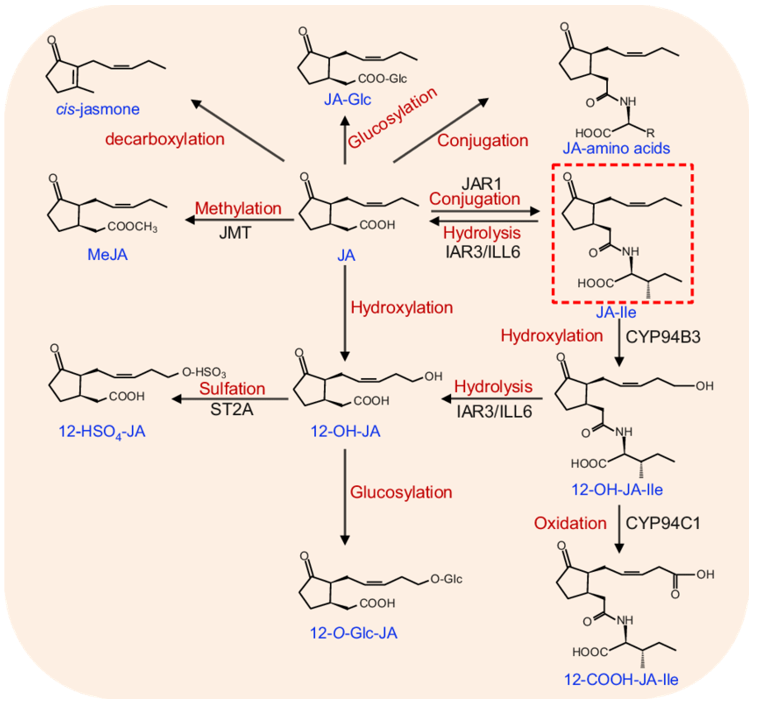v-innovate Technologies provides quantitative mass spectrometry (MS)-based jasmonates (JAs) analysis service to identify and quantify JAs in plants. We ensure maximized recovery rates and accurate profiling of JA. We also provide tailored statistical analysis and bioinformatics analysis to fit your project needs. Our complete sample-to-data services help botanists and chemists to better understand the functions of JAs and their mechanism of action.
Jasmonates (JAs) are a class of phytohormones that mediate signaling pathways of plant defense responses. JAs are derivatives of fatty acids, including compounds such as jasmonic acid (JA), jasmonate isoleucine conjugate (JA-ILE), methyl jasmonate (MEJA), dihydrojasmonic acid (H2JA), and 12-oxo-phytodienoic acid (12-OPDA). Accurate detection and absolute quantification of JA and its conjugate(s) are essential to better understand the JA-mediated signaling and metabolic pathways. Traditionally, gas chromatography-mass spectrometry (GC-MS) is used for JA analysis. However, this method involves the separation of high boiling compounds and long chromatographic separation at elevated temperatures that may cause thermal decomposition of the molecules, increasing the difficulty of quantifying small amounts of JA accurately. Tandem mass spectrometry (LC-MS/MS) technology is also widely applied to measure JAs since it is a powerful tool for rapidly and accurately measuring small metabolites, such as JA and its amino acid conjugates. v-innovate Technologies has developed a rapid method using LC-MS/MS for accurate jasmonate quantification in plants.
 Figure 1. Derivatives and metabolites of JA (Zhai Q et al., 2017).
Figure 1. Derivatives and metabolites of JA (Zhai Q et al., 2017).
Our newly developed sample preprocessing method provides safety, environmental protection, rapidness, effectiveness, and recovery rates consistently exceeding 85%. Sample preprocessing at v-innovate Technologies complies with in-house standard operation procedures (SOPs), ensuring maximized homogeneity between samples.

Quantification methods: external reference method or isotope-labeled internal standard method
Mode: MRM, capable of simultaneously detecting more than 1000 MRM ion pairs
Precision: ≤10-9 g
Positive/Negative polarity switching time: ≤20 ms, allowing for the acquisition of Q1/Q3 MRM transition mass spectra in both ionization modes from a single LC-MS/MS run.
| Detectable Jasmonates | CAS | Quantification Methods |
|---|---|---|
| JA | 3572-66-5 | External reference method / isotope-labeled internal standard method |
| H2JA | 3572-64-3 | External reference method / isotope-labeled internal standard method |
| JA-ILE | 120330-93-0 | External reference method / isotope-labeled internal standard method |
| 12-OPDA | 85551-10-6 | External reference method / isotope-labeled internal standard method |
| EMJA | 879490-89-8 | External reference method / isotope-labeled internal standard method |
1. Fresh plant tissues from leaf, flower, stem, root, or fruit: >2 g. Provide young plant tissues for best results. Samples should be frozen in liquid nitrogen immediately after collection, and then transferred to -80°C for storage.
2. Plant seeds: >2 g.
At least 3 biological replicates.
v-innovate Technologies provides plant hormones analysis services utilizing LC-MS/MS technology for accurate identification and quantitation of phytohormones and revelation of the roles of these molecules in plant regulation and stress responses. Please do not hesitate to contact us for detailed information about the jasmonate analysis service.
References
